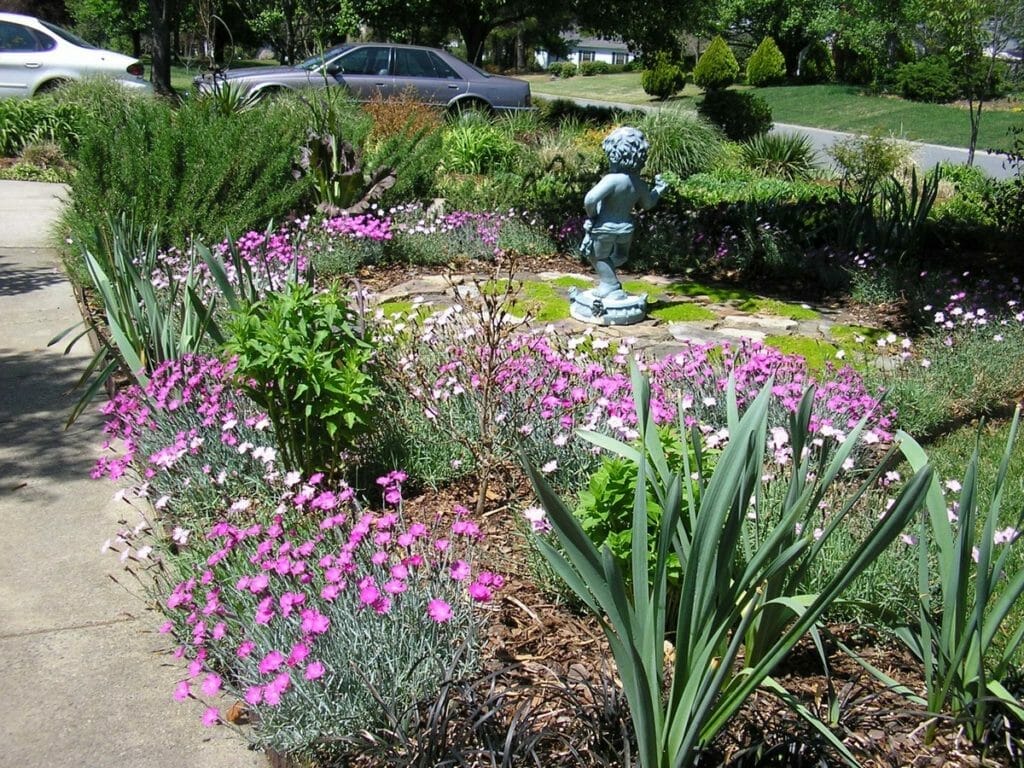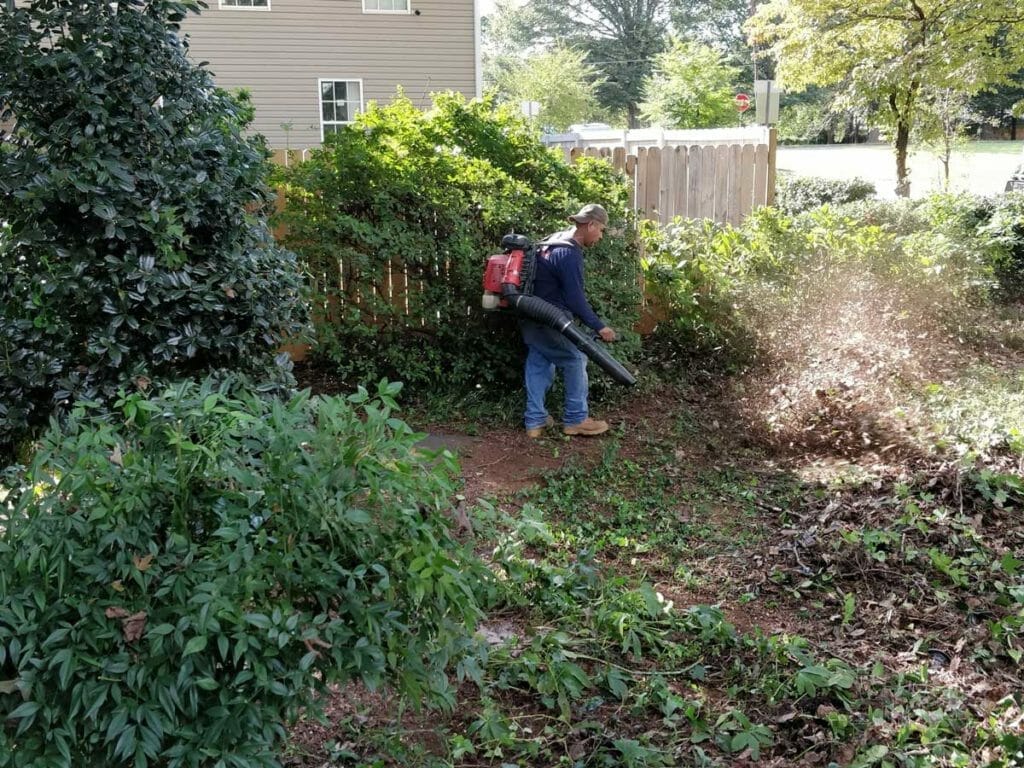Winter Landscaping Essentials: Protecting Charlotte Gardens from the Cold
As winter draws near in Charlotte, NC, the necessity of prepping your front and backyard cannot be overstated. This process is pivotal not only for surviving the frosty season but also for flourishing during it. Top Gardens Landscaping, with our specialized knowledge and deep expertise in tailored landscape solutions, is your ally. This guide, peppered with insightful strategies, equips you to enhance your garden’s resilience against the colder temperatures. Dive into this comprehensive article to transform your outdoor space into a robust, winter-resistant haven, where beauty and durability coexist harmoniously. Ready to embrace the colder months with confidence? Let’s begin.

Protect Your Trees and Shrubs
Caring for trees and shrubs during the cold season involves crucial steps. This section offers key strategies for robust tree protection, ensuring your greenery remains vibrant throughout the colder months.
Hydrate Before Frost Hits:
As the cold draws near, start by thoroughly watering your trees and shrubs. This step is vital to prevent dehydration due to the dry, chilly air. Soak the ground deeply around the roots, providing a solid moisture base that will support the plants as temperatures drop.
Burlap for Trunk Defense:
Wrap your tree trunks in burlap to shield them from cold winds and potential salt damage common in urban areas. Burlap is excellent for preventing physical damage and helps keep the trunk temperature regulated, which is essential for younger or more sensitive trees. Wrap from the base upward, ensuring the burlap fits snugly but isn’t too tight, and secure it with twine.
Fallen Leaves as Natural Mulch:
Those fallen leaves are more useful than you might think. Use them as natural mulch by layering them around the bases of trees and shrubs. These leaves help insulate the soil, maintaining more stable temperatures and retaining moisture. They also break down over time, enriching the soil with nutrients. Spread them generously around your plants, reaching as far as the drip line where possible.
Tending to Your Garden Beds

As winter nears in Charlotte, the right moves can boost both the beauty and the resilience of your garden beds. This section delves into perennial care, optimizing soil with compost, and the benefits of a more natural approach to plant management.
Plant Late-Season Perennials:
Butterfly Bush makes a great addition now. Its vibrant flowers attract pollinators and by planting before winter, you ensure it roots well, prepping it for a robust spring.
Post-Frost Composting and Mulching:
Once the frost hits, enrich your beds. Spread a good layer of compost to infuse vital nutrients. Then, mulch over this to lock in moisture and stabilize soil temperatures. This mulching layer acts like a cozy blanket, shielding the plants from severe cold and blocking weeds from sprouting.
Keep Some Plant Stalks:
Don’t chop all your dead plant stalks. Keeping them around through winter can be surprisingly beneficial. They provide critical shelter for wildlife and help insulate the soil, maintaining a mini ecosystem in your garden. This not only aids in plant protection but also enhances local biodiversity.
Lawn and General Landscape Maintenance
As winter looms in Charlotte, adept care of lawns and landscapes is crucial. Here we explore optimal strategies for leaf management and essential measures for safeguarding outdoor irrigation systems from the cold.
Optimal Leaf Management:
Make good use of the falling leaves rather than simply raking and discarding them. Mulching your leaves straight onto the grass can have two advantages: it gives beneficial animals a place to live during the colder months and nourishes the soil with nutrients as the leaves break down. This approach promotes a healthy ecology in your garden in addition to feeding the soil.
Winterizing Outdoor Water Systems:
Properly shutting down your outdoor water systems before the frost sets in is essential to preventing the expensive misfortune of burst pipes and ruined irrigation systems. To get rid of any remaining water, empty all irrigation systems, faucets, and hoses. Protect exposed pipes and spigots from freezing and potential damage by insulating them. This preventive care saves significant repair costs and ensures your systems are ready for the spring thaw.
Special Considerations for North Carolina Winters
Navigating the unique challenges of North Carolina winters calls for specific, targeted strategies. This section delves into frost protection, appropriate watering schedules, and caring for container plants during the colder months.
Adjusting Watering Schedules:
As temperatures dip, it’s crucial to modify your watering routine to prevent overwatering, which can lead to root issues and plant stress. Gauge the moisture level in your soil regularly and reduce the frequency of watering to align with the reduced evaporation rates during cooler weather.
Utilizing Frost Cloths:
Unprepared gardens might suffer greatly from unexpected frost. On cold nights, wrap your delicate plants with frost cloths. In order to prevent the accumulation of excessive humidity that may further chill the plants, these cloths are made to keep the cold out while letting moisture escape.
Protecting Container Plants:
Container plants are especially vulnerable to rapid temperature changes. Consider moving them to sheltered locations or indoors with less severe temperature fluctuations. For those that remain outside, wrapping the containers in bubble wrap or burlap can provide additional insulation, helping to maintain consistent soil temperatures.
Strategic Planting and Pre-Winter Plant Care

The foundation for a garden’s seasonal success in Charlotte is laid by careful pre-winter Garden maintenance and efficient autumn planting. The planting of shrubs and perennials, trimming advice, and the significance of watering evergreens before the frost are all covered in this section.
Choosing Shrubs and Perennials:
When adding new plants to your garden, select species that thrive in Charlotte’s specific climate zone. Consider shrubs and perennials that are known for their resilience to cold and their ability to bloom beautifully come spring. Planting at this time allows them to establish roots before the soil freezes.
Seasonal Pruning Techniques:
Selective pruning works best in the fall. In addition to making the plant seem cleaner, pruning out dead or dying branches will encourage more robust growth the following spring. To prevent new branches from being harmed by the cold, concentrate on plants that benefit from late-season trimming.
Watering Evergreens:
Before the ground freezes, make sure your evergreens are well watered. These plants may tolerate the dryness of winter if they receive a deep, thorough soaking in the late fall. Throughout the winter, evergreens continue to lose water through their leaves, thus having hydrated roots is essential to their survival.
Enhancing Plant and Soil Protection
Winter in Charlotte demands vigilant care for plants and soil to ensure they withstand the cold and thrive in the coming spring. This section outlines effective mulching techniques, the use of insulators like burlap, and strategies for creating windbreaks.
Mulching Techniques:
In order to preserve soil moisture throughout the dry winter months and shield plant roots from freezing temperatures, proper mulching is essential. Cover the base of your plants with a thick layer of organic mulch, such as straw or crushed bark. As it breaks down, this improves soil quality and inhibits weed development in addition to insulating the soil and roots.
Using Burlap and Other Insulators:
Sensitive plants may need extra protection from the cold. Covering them with burlap or using frost cloths can shield them from severe temperatures and drying winds. Wrap burlap loosely around the plants or create a burlap screen if the area is particularly exposed.
Creating Windbreaks:
Wind can exacerbate the chill factor and cause significant damage to both plants and property. Planting a barrier of evergreen trees and shrubs on the windward side of your garden can significantly reduce wind impact. Alternatively, installing burlap screens as temporary windbreaks can also be effective.
Winterizing Water Features and Tropical Plants
Winterizing your water features and caring for tropical plants in Charlotte requires specific steps to ensure their health and vitality through the cooler months. Here’s how to manage ponds and protect sensitive indoor plants.
Preparing Ponds and Managing Fish:
Remove any leaves and debris from your pond before winterizing it, since they can decompose and reduce oxygen levels, putting aquatic life at risk. Installing a de-icer to prevent a portion of the water’s surface from freezing can assist in maintaining essential oxygen levels and letting dangerous gasses out, preserving your fish throughout the winter.
Guidelines for Tropical Plants Indoors:
You can protect your tropical plants from harmful colds by bringing them indoors when the weather drops. To avoid indoor infestations, check each plant for pests and treat it with an appropriate pesticide before moving it indoors. Before moving your plants indoors, put them in a shady spot for a few weeks to gradually adjust them to reduced light levels. This ensures a smoother transition by lessening the shock caused by the environmental shift.
Overall Garden Health and Winter Readiness

As winter draws near in Charlotte, securing your garden’s health and readiness becomes critical. This section delves into effective garden cleanup techniques, strategies for invasive weed control, and the overall benefits of maintaining a tidy landscape.
Importance of Garden Cleanup:
Proper cleanup is essential to prevent diseases and pests from taking hold over the winter. Removing spent plant materials, fallen fruits, and debris helps reduce the risk of fungal diseases and insect infestations. This proactive approach not only promotes a healthier garden environment but also sets the stage for a vigorous start in the spring.
Strategies for Weeding:
Effective weeding is crucial for managing invasive species and ensuring they don’t overtake your garden. Carefully remove weeds, focusing on extracting their roots to prevent them from reestablishing. After weeding, applying a layer of mulch can help suppress further weed growth and provide a protective barrier for plant roots against the cold.
Benefits of Tidying Plant Areas:
Cleaning up around your plants not only minimizes the risk of disease and pest infestation but also improves the overall look of your landscape. Clearing away debris allows for better air circulation around plants, reducing excess moisture that can foster mold and mildew. Moreover, a tidy garden simplifies monitoring and managing any emerging issues early on.
Conclusion
It takes careful planning and thoughtful attention to detail to make sure your Charlotte landscape is prepared for winter. Every stage is essential to fortifying your garden against the winter weather, from mulching and trimming to safeguarding fragile plants.
Top Gardens Landscaping offers professional advice and comprehensive service catered to Charlotte’s unique climatic problems, whether you’re searching for specialist assistance or just want to improve the resilience of your landscape. To make sure your garden not only survives the winter but also comes out in the spring looking alive and healthy, think about getting in touch with Top Gardens Landscaping.
Top Gardens delivers top-quality landscaping and lawn care in Charlotte, NC, offering services like building retaining walls and other hardscaping features, landscape lighting, and more. Whether you need a small upgrade or a full transformation, our local experts are here to help. Contact us for more details or a free quote.
